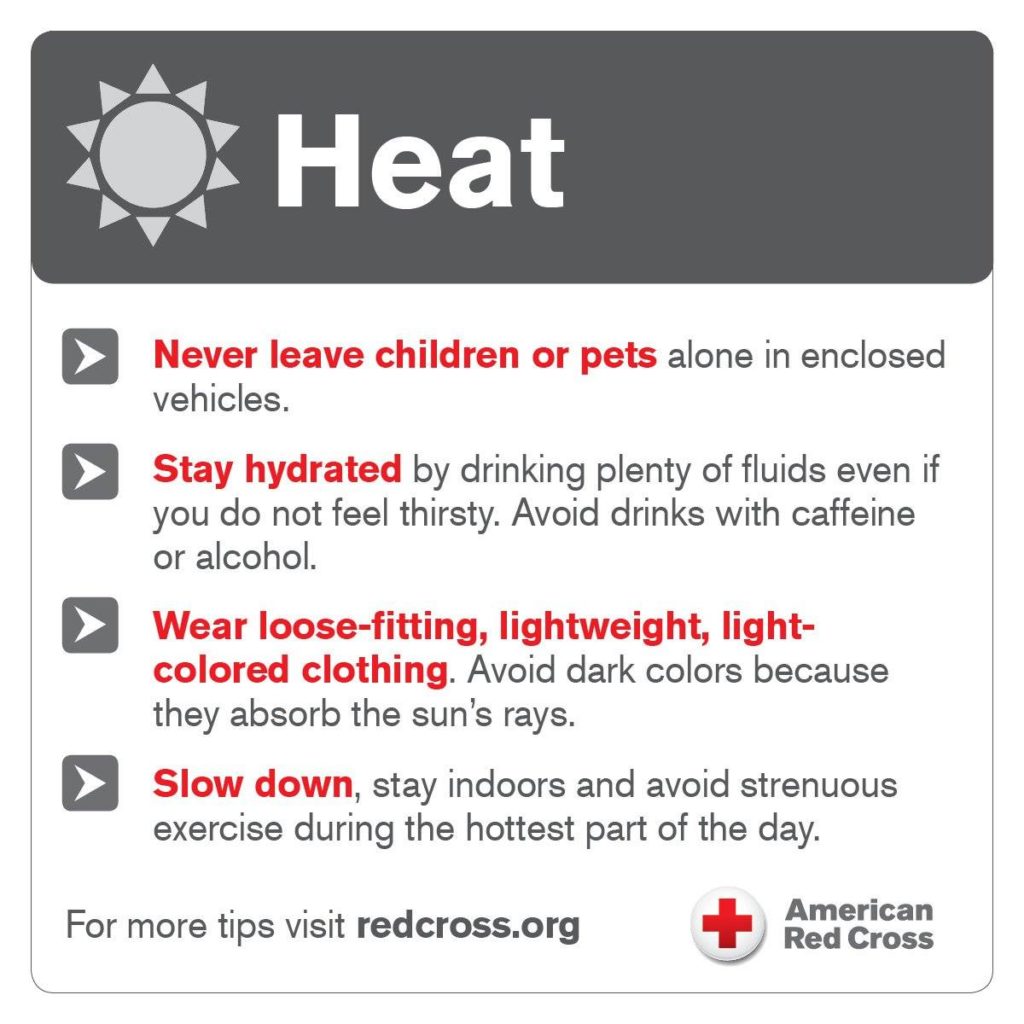Hot Weather Safety Tips
Triple digit temperatures are expected across the region this week and in order to stay safe, the American Red Cross urges residents to be aware of the steps they should take to avoid heat-related illness. Follow these simple steps to keep yourself and others safe before and during a heat wave.
Before
- Be aware of both the temperature and the heat index. The heat index is the temperature the body feels when the effects of heat and humidity are combined.
- Check the contents of your disaster preparedness kit to ensure it has enough water and non-perishable food items, just in case. For a full kit list, visit redcross.org/PrepareGuide.
- Look out for your neighbors — people who are elderly, young or sick are more susceptible to heat-related illness and may need your help.
- If you do not have air conditioning, locate places you could go to find relief from the heat during the warmest part of the day (schools, libraries, theaters, malls). Many government websites provide a list of available cooling centers.
- Ensure that your animals’ needs for water and shade are met.
During
- Listen to a NOAA Weather Radio for critical updates from the National Weather Service (NWS).
- Never leave children or pets alone in enclosed vehicles, not even for a few minutes. According to the National Weather Service, a car left in 80 degree weather yielded an inside temperature of 95 degrees and rising in just two minutes.
- Stay hydrated by drinking plenty of fluids even if you do not feel thirsty. Avoid drinks with caffeine or alcohol.
- Eat small meals and eat more often.
- Wear loose-fitting, lightweight, light-colored clothing. Avoid dark colors because they absorb the sun’s rays.
- Slow down, stay indoors and avoid strenuous exercise during the hottest part of the day (late afternoon/evening).
- Postpone outdoor games and activities (participants and spectators).
- Use a buddy system when working in excessive heat.
- Take frequent breaks if you must work outdoors.
- Check on family, friends and neighbors who do not have air conditioning, who spend much of their time alone or who are more likely to be affected by the heat.
- Check on your animals frequently to ensure that they are not suffering from the heat.

How to Treat Heat-Related Illnesses
During heat waves, people are susceptible to several heat-related conditions. Here’s how to recognize and respond to them.
Heat Cramps
Heat cramps are muscular pains and spasms that usually occur in the legs or abdomen. Heat cramps are often an early sign that the body is having trouble with the heat.
- Get the person to a cooler place and have him or her rest in a comfortable position. Lightly stretch the affected muscle.
- Give an electrolyte-containing fluid, such as a sports drink. Water may also be given.
Heat Exhaustion
Heat exhaustion is a more severe condition than heat cramps. Heat exhaustion often affects athletes, firefighters and construction workers. It also affects those wearing heavy clothing in a hot, humid environment.
- Signs of heat exhaustion include cool, moist, pale, ashen or flushed skin; headache; nausea; dizziness; weakness; and exhaustion.
- Move the person to a cooler environment with circulating air. Remove or loosen as much clothing as possible and apply cool, wet towels to the skin. Fanning or spraying the person with water also can help. If the person is conscious, give small amounts of a cool fluid such as a sports drink or fruit juice to restore fluids and electrolytes. Give about 4 ounces of fluid every 15 minutes.
- If the person’s condition does not improve or if he or she refuses water, has a change in consciousness or vomits, call 9-1-1.
Heat Stroke
Heat stroke is a life-threatening condition that usually occurs by ignoring the signals of heat exhaustion. Heat stroke develops when the body’s systems are overwhelmed by heat and begin to stop functioning.
- Signs of heat stroke include extremely high body temperature; red skin which may be dry or moist; changes in consciousness; rapid, weak pulse; rapid, shallow breathing; confusion; vomiting; and seizures.
- Heat stroke is life-threatening. Call 9-1-1 immediately if you believe someone is suffering from this condition.
- Rapidly cool the body by immersing the person up to the neck in cold water, if possible OR douse or spray the person with cold water.
- Cover the person with bags of ice or cold, wet towels.
- If you are not able to measure and monitor the person’s temperature, apply rapid cooling methods for 20 minutes or until the person’s condition improves.
Download the Red Cross Emergency App
- Find the FREE Red Cross Emergency App in the Apple Store or Google Play
- It offers a Heat Wave Safety Checklist, among many other resources
- It provides expert medical advice right at your fingertips
- It’s available in multiple languages
One thought on “Hot Weather Safety Tips”
For safety purposes, high visibility colors and reflective stripes are going to make you far more visible.
Safety vest
Comments are closed.